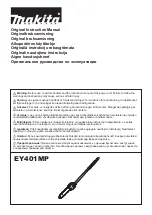
41
English
Blade Guard Assembly (Fig. 13)
TO ATTACH BLADE GUARD ASSEMBLY
WARNING:
To reduce the risk of serious personal injury, the blade guard assembly must
be in place for all possible cuts.
1. While holding the blade guard assembly (D) slide the locating pin (HH) into the riving knife slot
(II) centering the riving knife within the v-shaped notch in the guard.
2. Slide and hold the blade guard lock lever (W W) up and press the blade guard assembly down
until the entire assembly is flat on the riving knife. Release the blade guard lock lever.
3. Ensure the guard is locked onto the riving knife. If the guard is not locked, repeat steps 1
and 2.
FIG. 13
II
D
HH
W W
W W
TO REMOVE THE BLADE GUARD ASSEMBLY
Slide the blade guard lock lever (W W) up and remove blade guard assembly from riving knife
slot.
Rip Fence
The rip fence can be installed on the left or right side of your table saw.
RIP FENCE ASSEMBLY (FIG. 14)
1. Lift up the rip fence latch (G) to release the holding clamp (AA).
2. Hook the holding clamp (AA) onto the rear fence rail (F) and lower the front of the fence
onto the front fence rail.
3. Push down the rip fence latch (G) to lock the rip fence in place. Ensure the fence is secure.
G
FIG.14
AA
F
Miter Gauge (Fig. 15)
NOTE:
A large auxiliary miter gauge face may be used.
TO ATTACH THE MITER GAUGE
The DWE7470 includes a miter gauge
FIG. 15
JJ
for crosscutting materials. The miter
gauge can be used by insertion into
one of the two miter gauge slots (JJ) in
the table top.
NOTE:
See
Crosscutting
and
Bevel
Crosscutting
instructions under
Adjustments
before performing these
operations on the table saw.
To Bench Mount Saw
(Fig. 4)
NOTE:
A portable table saw stand is
designed for use with this saw and is
available at a local D
E
WALT dealer or
service center at extra cost.
WARNING: To reduce the risk of serious personal injury, turn unit off and
disconnect machine from power source before attempting to move it, change
accessories or make any adjustments.
An accidental start-up can cause injury.
CAUTION:
To reduce the risk of personal injury, make sure table saw is firmly mounted
before use.
The table saw must be mounted firmly. Four mounting holes (N, Fig. 4) are provided in the
metal frame for mounting. We strongly recommend that these holes be used to anchor the
table saw to your workbench or other rigid, stationary work support.
CAUTION:
Ensure that the surface is stable enough that large pieces of material will not
cause it to tip over during use.
1. Center the saw on the desired, stable work surface.
2. Drive four 3-1/2" (88.9 mm) long screws through the holes in the metal frame. Make sure
the screws extend through the frame and securely attach to the supporting work surface.
If marring the supporting work surface is a concern, the DWE7470 can be mounted to scrap
wood which can then be clamped onto the desired work surface.
1. Cut a piece of 3/4" (19 mm) plywood to fit beneath the footprint of the saw.
2. Screw the saw to the plywood and clamp the overhang of the plywood to the work
surface. If the screws protrude through the plywood base, set it on two scrap pieces of
material of equal thickness and attach them to the edges of the plywood to hold the saw
further off of the work surface and prevent the screws from marring the surface.
Connecting Saw to Power Source
WARNING: To reduce the risk of injury,
before connecting saw to power source, make
sure the switch is in the OFF position.
Be sure your power supply agrees with the nameplate marking. AC Only means that your saw
will operate on alternating current only. A voltage decrease of 10 percent or more will cause
a loss of power and overheating. All D
E
WALT tools are factory tested. If this tool does not
operate, check the power supply.














































